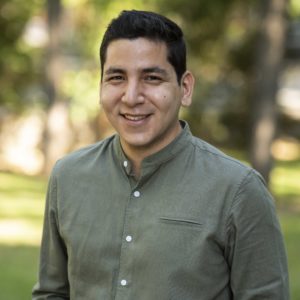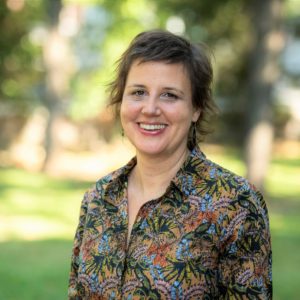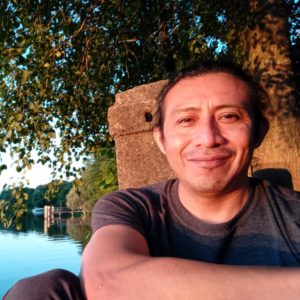Historical Indigenous diplomacy for taking care of Mother Earth and the Rights of Nature
Reading time : 9 minutesAfter decades of Indigenous diplomacy efforts at the UN concerning the concept of “Mother Earth-Nature”, there has been a growing recognition of the Rights of Nature (RoN). In an article drawing upon findings from interviews with Indigenous delegates, UN officers and NGO representatives, the RIVERS project examines the contradictions that RoN activism could have in terms of respecting Indigenous Peoples’ rights.
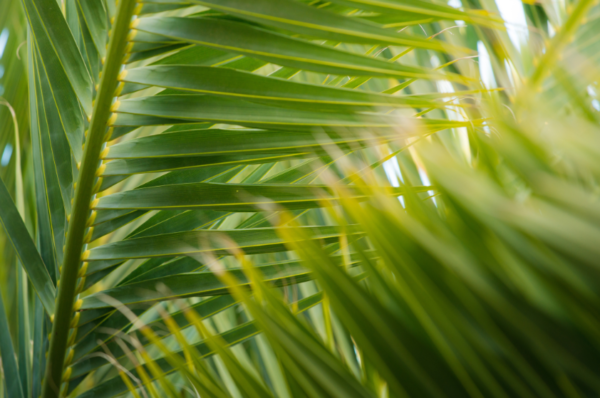
Contributors : Manuel May, Lieselotte Viaene, Digno Montalvan
Indigenous diplomacy[1]at the United Nations has its symbolic origin in 1923 with the visit of Deskaheh Levi General to the incipient League of Nations in Geneva. Although Deskaheh Levi, in his role as the spokesperson of the Haudenousanee peoples (Canada-USA), was not received by the states gathered in Geneva, the then Mayor of the city Mr. Jean-Baptiste Pons extended an invitation to him to deliver his message to the local society. A hundred years later, in July 2023 the current Deskaheh Steve Jacobs, a Haudenousanee delegation and the Mayor of Geneva Alfonso Gomez met in an official reception at Palais Anna and Jean-Gabriel Eynard on the occasion of the centenary of the first encounter.
In the light of the recent eco-legal developments and emerging transnational frameworks which call for a shift from a human-centered to an eco-centred approach, efforts of Indigenous diplomacy at the UN regarding the Indigenous concept of “Mother Earth-Nature” amalgamated from the diverse Indigenous ontologies and philosophies of various continents throughout these more than four decades of advocacy in the international law arena become even more relevant. This blog entry draws upon the empirical research developed within the six years European Research Council (ERC) funded projectRIVERS-Water/human rights beyond the human? Indigenous water ontologies, plurilegal encounters and interlegal translation. This project aims to engage in a dialogue between mainstream human rights theory and emerging theories and conceptual frameworks that challenge the anthropocentric nature of the human rights framework. One of the research questions seeks to grasp the main obstacles, success factors and lessons learned in acquiring an international normative space that recognizes counter-hegemonic visions of human rights related to water, life and “nature”. This post aims to put the spotlight on the contradictions in the increasingly frequent use of the Mother Earth-Nature concept in international law and environmental activism. The post draws on the preliminary findings from 25 interviews with Indigenous delegates, UN officers and NGO representatives conducted in the context of the Workshop on Enhancing Indigenous Peoples’ Participation and the 16th session of EMRIP, held at UN Headquarters in Geneva in 2022 and 2023 respectively, as well as the RIVERS seminar (2019) “The Rights of Nature: A Legal Revolution or Ontological Conflicts?”, with the participation of the then UN Special Rapporteur of Indigenous peoples Rights and the then chair of the UN Permanent Forum of Indigenous Issues.
1/ The current state of Indigenous Peoples’ participation in UN processes
Against the background of these emerging socio-legal debates, the ERC RIVERS project is concerned about “who frames the debates and who owns and presents the knowledge” (Lykes and van der Merwe, 2019).
It is important to recognize that after a century of Indigenous diplomacy and advocacy, UN mechanisms – such as Expert Mechanism on the Rights of Indigenous Peoples (EMRIP), the Permanent Forum on Indigenous Issues and the Special Rapporteur on the Rights of Indigenous Peoples – embody some of the major achievements in gaining access to the UN Human Rights system and introducing counter-hegemonic views on the dominant human rights paradigm marked by an anthropocentric dogma. To date, however, the UN human rights system does not recognise the same status for Indigenous Peoples as for states in their participation in the UN Human Rights Council. Indigenous delegates are only allowed to take the floor through NGOs (Indigenous and non-Indigenous) with ECOSOC status.
The global Indigenous movement began to consolidate after the 1977 NGO conference in Geneva and it is within this movement that Indigenous Peoples have pushed the concept of Mother Earth in a number of official statements before the UN member states.[2]For example at the 15th session of the United Nations Working Group on Indigenous Populations (WGIP)- as for 2007 replaced by EMRIP – in 1997, Ingrid Washinawatok (Menominee, USA) pointed out:
The members have heard numerous Indigenous delegates eloquently state their peoples philosophy on our connection – as peoples of the Earth – to our mother – the Earth. This philosophy is not a quaint story or a superstitious belief. Indigenous women of the world share the responsibility of being life-givers as Mother Earth is a life giver. It has been said by our ancestors that whatever you see happening to the women of the Earth is a sign as to what is happening to the Earth and vice versa.
Moreover, the thirty years old Kari-Oca Declaration and Indigenous Peoples Earth Charter (1992), arising from the United Nations Conference on Environment and Development (UNCED) (also known as Earth Summit, which took place in Brazil), includes important references:
Indigenous Peoples were placed upon our Mother, the Earth, by the Creator. We belong to the land. We cannot be separated from our lands and territories (art. 31)
Our territories are living totalities in permanent vital relation between human beings and nature. Their possession produced the development of our culture. Our territorial property should be inalienable, unceasable and not denied title. Legal, economic and technical backup are needed to guarantee (art. 32)
Further in article 77, this historic Declaration recognizes that: “The eurocentric notion of ownership is destroying our peoples. We must return to our own view of the world, of the land and of development. The issue cannot be separated from Indigenous People’s rights.”
One could say that the Mother Earth concept involves spirituality and a relationship with nature that is opposed to the anthropocentric vision of domination. Yet, elaborating this concept and linking it to the human rights regime is not as simple as it looks. In fact, it would take each particular Indigenous community several days to elaborate on what Mother Earth-Nature means to them in terms of rights, as Mike Myers (Seneca and Haudenousanee representative, USA) points out in 2013:
So if we were to recount not only what we would call the rights of our Mother the Earth, but the rights of all beings here, on this Earth, it would take us about two months…to go through all of that and to have discussions and to keep understanding what all that means.
However, it has been recognized that in dominant Euro-western legal scholarship and law, the “earth and the realm of the more-than-human are rendered visible and accessible to legal intervention, for the most part, only when these phenomena have been translated into the language of natural resources or a commodity” (Viaene, Doran and Liljeblad, 2023).
2/ Mother Earth, loudly trumpeted from the UN to the world
A historical milestone in Indigenous diplomacy at the UN was the adoption in 2007, , of the UN Declaration on the Rights of Indigenous Peoples (the Declaration), after thirty years since the first meeting between Indigenous Peoples and UN Member States. Although the Declaration does not include the terms Mother Earth-Nature, the amalgamated concept that Indigenous Peoples have been pushing for three decades at the United Nations, it does include the general principles of this concept in several of its articles. In particular, Article 27 stresses the importance of “their distinctive spiritual relationship with the lands, territories, waters, coastal seas and other resources which they have traditionally owned or otherwise occupied and used”.
Another diplomacy triumph was that following the Declaration, the UN General Assembly unanimously approved the resolution A/63/L.69 in 2009 – pushed by Bolivia and its Indigenous president Evo Morales -designating April 22 as International Mother Earth Day. The momentum generated by resolution A/63/L.69, widely applauded and celebrated globally, led to the holding of the World People’s Conference on Climate Change in Bolivia in 2010, where civil society and several State representatives adopted the Universal Declaration on the Rights of Mother Earth.
It should also be recognized that through the continuous drive of Indigenous diplomacy, the Indigenous Peoples movement at the UN has been able to establish strategic alliances, among others, with the green movement and the big environmental NGOs attending the UN COP Climate Change Conferences. The protection and preservation of “nature” has served as a meeting point in these alliances, leading to achieve significant results, such as the 1992 United Nations Convention on Biological Diversity. Indigenous diplomacy also led to the incorporation of the Mother Earth-Nature concept within the international environmentalist movements that equally seek to curb climate change and the effects of the anthropocene. At the same time, despite the points of connection, it is necessary to draw attention to the fact that the demands of the green movements differ substantively in philosophy and worldview from those of the Indigenous Peoples. The spiritual and economic relationship with the land are starting points from which such differences can be identified on both sides.
During the interviews, we learned that the road was not smooth for the Indigenous delegates who pushed this concept decades ago at the different UN spaces. Ontological barriers and systemic obstacles within the UN were coupled with discrimination, even within environmental groups pursuing a common goal with that of Indigenous Peoples. Mrs. Tarcila Rivera Zea, Quechua Chanka (Peru) and former member of the UN Permanent Forum on Indigenous Issues, summarizes it as follows:
“Back then [when negotiating about the Declaration] they made fun of our philosophy, of our cosmovision… And then they called us pachamamists[3]. And now it is the non-Indigenous who have this discourse of Mother Nature… which is equally dangerous, isn’t it?” [4]
3/ The growing recognition of the Rights of Nature and the contradictions of this activism
Currently, the growing recognition of the Rights of Nature (RoN), in which legal personhood is granted to natural entities and ecosystems is increasing around the world—to the point where such discourse has generated a kind of “legal hype” (Viaene, 2022). RoN proponents often emphasize that this is rooted in Indigenous values and practices of inhabiting the world that prioritizes living in harmony with nature.[5] However, the former United Nations Special Rapporteur on the Rights of Indigenous Peoples Vicky Tauli-Corpuz expressed her concerns about possible tensions between this emerging legal framework and the already international recognised collective rights of Indigenous Peoples:
“I was wondering how these people [who] are pushing for the legal framework [are] going to respect and protect the rights of Indigenous Peoples to continue developing further, and using their own philosophies and cosmologies and worldviews” (personal interview by Lieselotte Viaene, 2019)
Similarly, the current EMRIP member, Dalee Sambo Dorough (Iñupiaq, Alaska) calls for prudence when discussing the rights of Earth-Nature:
“This concept, however, of the notion of the rights of Mother Earth, I think this is an area where Indigenous Peoples have to be very careful because then it becomes subjective: Who is speaking on behalf of quote unquote “Mother Earth”?” (personal interview by Manuel May, 2023)
At the same time, critical legal scholarship has also been pointing out several risks of the RoN activism such as the undermining of historical Indigenous struggles for sovereignty and ownership of their lands and romanticizing and even recolonizing of Indigenous knowledges and ontologies (Macpherson 2021, Viaene 2022, Tanasescu 2022, Gilbert 2022)
We argue that the multiple contradictions in the increasingly Mother Earth-Nature rights advocacy in environmental activism and International law, even pursuing a common dream with that of Indigenous Peoples’ struggles, needs more critical attention. For example, a re-focused lens is needed on the particularities of Indigenous Peoples at the local level.
Bearing in mind that Indigenous Peoples speak more than 4000[6] languages in the world, and that Indigenous languages convey particular ways of understanding, being and co-existing with the Earth-Nature of each people, UN normative documents such as the Declaration aim to harmonize the more than 4000 ways of coexistence and cohabiting this world. This concern is acutely felt by Indigenous delegates and officers of the above-mentioned UN mechanisms.
In this regard, it is urgent to deepen the focus into the contradictions of movements advocating the Rights of Mother Earth-Nature globally. It is not our intention to totally reject or throw the RoN baby out with the bathwater, because to a certain and even an important extent, RoN proponents seek to make a counter-hegemonic use of the human rights paradigm. However, the growing universalization of the ecocentric turn discourse deserves to be problematized further, certainly in the light of almost a century of Indigenous diplomacy for ensuring meaningful care of Mother Earth by the United Nations. Many questions arise, such as a) to what extent are these eco-centric turn movements, such as RoN, willing to acknowledge and even promote Indigenous sovereignty? b) In terms of legal diplomacy and advocacy, who are Mother Earth’s real spokespersons? But, above all, c) how could non-Indigenous legal practitioners involved in legal diplomacy regarding “nature”, “environment”, “ecosystems” engage respectfully and without further recolonizing Indigenous ontologies and practices?
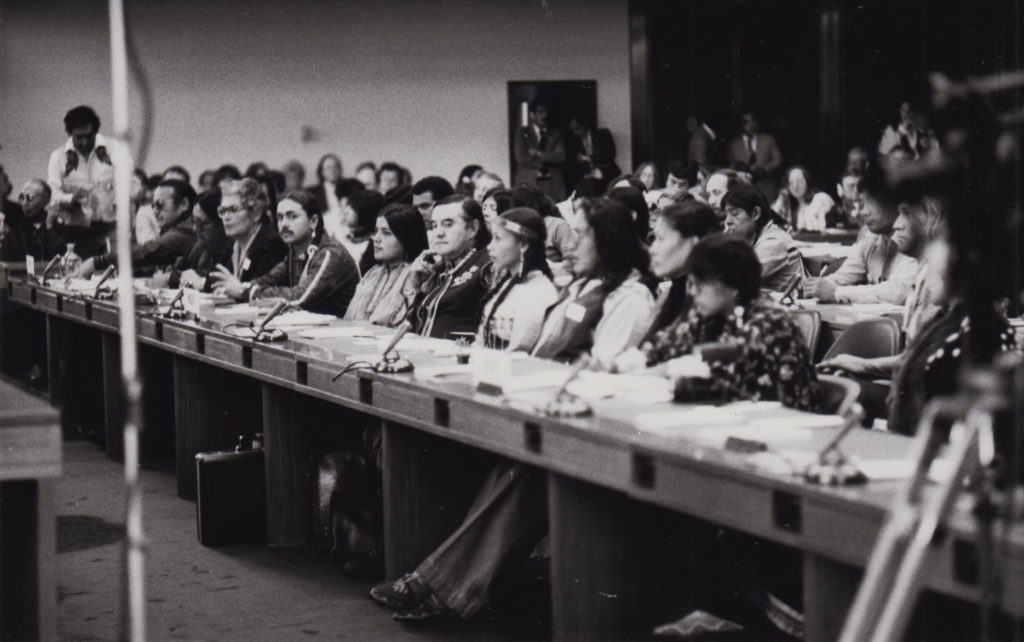
Indigenous Delegates at the International NGO Conference on Indigenous Peoples and the Land. UN Geneva, Switzerland, 15-18 September 1981. Photo by Beatrice Weyrich, courtesy DOCIP database.
References
Footnotes
[1] In this entry, we consider Indigenous Diplomacy in contrast with the state-centric definitions of diplomacy and as an integral component of the diverse, intricate, nuanced, and sui generis Indigenous Diplomacies as elaborated in Beier 2009.
[2] This is based on our findings while reviewing the historical documents of the Indigenous movement archived by DOCIP at its documentation center.
[3] From Pacha Mama, which is how Quechua and Aymara peoples refer in their own language to the concept of Mother Earth-Nature.
[4] Personal interview by Manuel May, 2023. Translation into English by the RIVERS team.
[5] See a critique on the blind spots and concerns of RoN snowballing effect in Viaene 2022.
[6] https://www.un.org/es/events/indigenousday/assets/pdf/Backgrounder-Languages-Spanish%202019.pdf
Further references
- Beier, J. M. (2009). Introduction: Indigenous Diplomacies as Indigenous Diplomacies. In Indigenous Diplomacies (pp. 1–10). Palgrave Macmillan.
- Jérémie Gilbert, 2022, The rights of nature, indigenous peoples and international human rights law: from dichotomies to synergies, Journal of Human Rights and the Environment, Vol. 13, Issue 2, pp. 399-415.
- Lykes, M. B., & Merwe, H. van der. (2019). Critical Reflexivity and Transitional Justice Praxis: Solidarity, Accompaniment and Intermediarity. International Journal of Transitional Justice, 13(3), 411.
- Macpherson, E., Borchgrevink, A., Ranjan, R. & Vallejo Piedrahíta, C. (2021). Where ordinary laws fall short: ‘Riverine rights’ and constitutionalism. Griffith Law Review, 30 (3), pp. 438-473.
- Minhea Tanasescu, (2022). Understanding the Rights of Nature. A Critical Introduction (Bielefeld: Transcript, 2022).
- Rivera Zea, T. (2023, July 6). Personal interview (M. May Castillo, Interviewer) [Online]. RIVERS archive.
- Sambo Dorough, D. (2023, July 20). Personal interview (M. May Castillo, Interviewer) [In person]. RIVERS archive.
- Tauli-Corpuz, V. (2019, November 8). Personal interview (L. Viaene, Interviewer) [In person]. RIVERS archive.
- Viaene, L. (2022). Can Rights of Nature Save Us from the Anthropocene Catastrophe? Some Critical Reflections from the Field. Asian Journal of Law and Society, 9(pp. 187-206), Article 2. https://doi.org/10.1017/als.2022.2
- Viaene, L., Doran, P., & Liljeblad, J. (2023). Editorial Special Section: ‘Transitional Justice and Nature: A Curious Silence’. International Journal of Transitional Justice, 17(1), 1–14. https://doi.org/10.1093/ijtj/ijad007
- Washinawatok, I. (1997, July 23). Intervention Agenda Item 5 [Statement]. XVth Session of the Working Group on Indigenous Populations, Geneva. https://cendoc.docip.org/collect/cendocdo/index/assoc/HASH012f/52ac5f32.dir/970305.pdf

